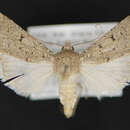Conservation Status
fornecido por University of Alberta Museums
A fairly common widespread species
- licença
- cc-by-nc
- direitos autorais
- University of Alberta Museums
Cyclicity
fornecido por University of Alberta Museums
Adults have been collected in Alberta from late July - early September, peaking in late August.
- licença
- cc-by-nc
- direitos autorais
- University of Alberta Museums
Distribution
fornecido por University of Alberta Museums
In Alberta pallipennis has been collected in the arid grasslands and badlands, north to Dinosaur Provincial Park. There is also a specimen in the Bowman collection supposedly collected at Nordegg.
- licença
- cc-by-nc
- direitos autorais
- University of Alberta Museums
General Description
fornecido por University of Alberta Museums
"A medium-size Euxoa (3.0-3.7 cm wingspan) with light grey-brown or yellow-brown forewings and shining white hindwings. Only the antemedian and postmedian lines are prominent; the former is nearly straight, the latter finer and finely scalloped at the veins. The orbicular is a large oval, filled with scales slightly paler than the ground while the reniform is obscure, outlined with a few dark scales and filled with the same color as the ground. The claviform is usually indicated by a small patch of dark scales. The median portion of the subterminal area is somewhat darker than the rest of the forewing, and the fringe is a mix of whitish and light brown scales. The most prominent marking is the space before the orbicular and between the orbicular and reniform spots, which are filled or nearly so with dark scales. The hindwings are shining white, with a few light brown scales marking the veins and forming an obscure, narrow terminal band (darker in females). The fringe is white.
Most similar to E. misturata. Pallipennis males can be identified by the short, bladelike saccular extensions with a slight twist about 2/3 of the distance from the base, with the apex projecting dorsally toward the cucullus and slightly outside. The shape of the vesica and its pouches (and in particular that of the subbasal diverticulum) is also characteristic. Females differ from misturata and similar species by the absence of fused margins or sclerotized flange-like projections on the ovipositor lobes.
Euxoa pallipennis belongs to the subgenus Euxoa, characterized mainly by the shape of the vesica in males. Keys to the subgenera and species and illustrations of the genitalia are provided in Lafontaine, 1987.
"
- licença
- cc-by-nc
- direitos autorais
- University of Alberta Museums
Habitat
fornecido por University of Alberta Museums
Arid shortgrass prairie, sagebrush grasslands and arid croplands.
- licença
- cc-by-nc
- direitos autorais
- University of Alberta Museums
Life Cycle
fornecido por University of Alberta Museums
Poorly known. There is a single annual brood. The adults are attracted to light. The larvae have not been described.
- licença
- cc-by-nc
- direitos autorais
- University of Alberta Museums
Trophic Strategy
fornecido por University of Alberta Museums
Russian thistle (Salsola kali) was reported to be a favored host in Montana, where it was also found to be an occasional pest on wheat (Cook, 1930),
- licença
- cc-by-nc
- direitos autorais
- University of Alberta Museums
Euxoa pallipennis
(
Inglês
)
fornecido por wikipedia EN
Euxoa pallipennis is a species of cutworm or dart moth in the family Noctuidae. It is found in North America.[1][2][3]
The MONA or Hodges number for Euxoa pallipennis is 10765.[4]
References
- licença
- cc-by-sa-3.0
- direitos autorais
- Wikipedia authors and editors
Euxoa pallipennis: Brief Summary
(
Inglês
)
fornecido por wikipedia EN
Euxoa pallipennis is a species of cutworm or dart moth in the family Noctuidae. It is found in North America.
The MONA or Hodges number for Euxoa pallipennis is 10765.
- licença
- cc-by-sa-3.0
- direitos autorais
- Wikipedia authors and editors
Euxoa pallipennis
(
Neerlandês; Flamengo
)
fornecido por wikipedia NL
Insecten Euxoa pallipennis is een vlinder uit de familie van de uilen (Noctuidae).[1] De wetenschappelijke naam van de soort is voor het eerst geldig gepubliceerd in 1887 door Smith.
Bronnen, noten en/of referenties Geplaatst op:
12-04-2013
Dit artikel is een beginnetje over biologie. U wordt uitgenodigd om op bewerken te klikken om uw kennis aan dit artikel toe te voegen.

- licença
- cc-by-sa-3.0
- direitos autorais
- Wikipedia-auteurs en -editors
Euxoa pallipennis
(
Vietnamita
)
fornecido por wikipedia VI
Euxoa pallipennis là một loài bướm đêm trong họ Noctuidae.[1][2]
Chú thích
-
^ Bisby F.A., Roskov Y.R., Orrell T.M., Nicolson D., Paglinawan L.E., Bailly N., Kirk P.M., Bourgoin T., Baillargeon G., Ouvrard D. (red.) (2011). “Species 2000 & ITIS Catalogue of Life: 2011 Annual Checklist.”. Species 2000: Reading, UK. Truy cập ngày 28 tháng 6 năm 2014.
-
^ Beccaloni, G. W., Scoble, M. J., Robinson, G. S. & Pitkin, B. (Editors). (2003) The Global Lepidoptera Names Index (LepIndex). (Geraadpleegd maart 2013).
Liên kết ngoài
- licença
- cc-by-sa-3.0
- direitos autorais
- Wikipedia tác giả và biên tập viên
Euxoa pallipennis: Brief Summary
(
Vietnamita
)
fornecido por wikipedia VI
Euxoa pallipennis là một loài bướm đêm trong họ Noctuidae.
- licença
- cc-by-sa-3.0
- direitos autorais
- Wikipedia tác giả và biên tập viên

